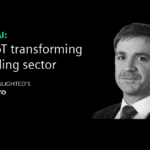
CTO Insights: Leveraging AI and IoT for Smarter, More Sustainable Buildings
In the Siemens AI Lab’s newest episode of the Human & AI Podcast, hosts Ulli and Arberie discuss the future of AI in the building sector with Enlighted CTO Colm Nee. Colm shares how IoT and AI enable sustainable buildings while exploring the challenges hindering the adoption of AI–and the opportunities it brings to scale transformation at enterprises and the industry at large.
The Impact of Buildings on Global Carbon Emissions
Buildings significantly affect global carbon emissions, contributing to 37 percent of yearly emissions. Reduction targets are crucial, with more than 75 percent of necessary emission reduction needing to come from avoided demand, energy efficiency, or electrification of building systems. Despite this, only 35 percent of countries have mandatory building energy regulations.
The Human Element is Key
At the building level, Colm shares that sustainability challenges often boil down to human decisions and behavior. Providing occupants transparency and some control over building systems can significantly shift energy use patterns. Enlighted’s Comfy app is one example—by letting occupants vote on temperature preferences, HVAC setpoints can be widened while maintaining comfort. Empowering people is a win-win for both occupant experience and efficiency.
“I think everything traces back to humans,” Colm shares. “That’s the common thread, whether we’re talking about societal problems or we’re talking about energy savings.”
Automation Fills in the Gaps
However, even well-intentioned people forget to turn off lights, adjust thermostats, etc. This is where intelligent building controls and AI-powered automation can make a significant impact.
“What we do at Enlighted is really try and go beyond just using AI to spit out facts about the building or even recommend things. We really try and go to automation.”
For example, Enlighted’s sensor networks track occupancy, temperature, and light levels to feed algorithms that make intelligent decisions about automatically turning the systems on or off. This drives significant cost savings for commercial buildings by avoiding unnecessary energy demand.
Leveraging AI in Enterprises: Opportunities and Challenges
Key innovations, such as the open-sourcing of models like LLaMA and the addition of chat interfaces, have influenced and accelerated the development of AI technology–advancements that have driven the widespread consumer adoption of AI.
Generative AI, such as GPT-3 and DALL-E, is transforming personalization and creativity in business, Colm shares. By generating personalized content based on individual preferences, businesses can enhance customer experiences. The integration of generative AI in workflows increases productivity and streamlines communications with customers.
However, data security, privacy, and organizational alignment hinder widespread enterprise adoption of AI, including in the building sector. Executives play a crucial role in making informed decisions about implementing and utilizing AI technologies within enterprises–and it’s not just the CIO anymore.
“Maybe 10 years ago, data science and AI would have been more of a CIO topic,” Colm says. “Nowadays, that’s been elevated to being a CEO topic.”
Colm shares that the industry is also seeing the emergence of a ‘Copilot’ concept where AI acts as a personal assistant to boost productivity within workflows. “AI is taking us from the era of widely available information to the era of widely available intelligence,” Colm shares.
Interoperability is the Next Frontier
A persistent problem has been getting disparate building software and systems to share data for holistic optimization. Colm notes that buildings are still “snowflakes” – unique assemblies of systems that don’t interoperate well. He believes AI will be essential to processing and making sense of all this data, connecting the dots across lighting, HVAC, security systems, and more. Building a common language to get systems talking through AI is critical for scaling efficiencies and sustainability outcomes.
The Future of the Industry is Bright
With wireless sensors are coming down in price, and battery life is improving from 2 years to 10-15 years, Colm predicts IoT technologies will become more affordable and accessible. To accelerate this, for example, Enlighted aims to open up their network for any sensor or device to piggyback on. This ecosystem approach, Colm predicts, will help scale IoT adoption.
With AI and IoT transforming how built environments function, interact and respond, it’s an exciting time to be in the technology industry, especially technology for sustainability, Colm says.
“As a CTO, you need to be passionate about not only the technology but also the problems you’re solving… To have longevity in any role or any industry, you have to fall in love with both.”
Listen to the full episode HERE.
The brightest way to operate, orchestrate, and optimize everyday spaces.


